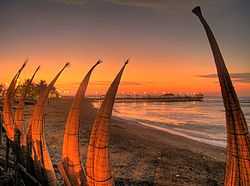Caballito de totora
_01.jpg)

Caballitos de totora are reed watercrafts used by Peruvian fishermen for the past 3,000 years, archaeologically evidenced from pottery shards.
Named for the way they are ridden, straddled ('little reed horses' in English), fishermen use them to transport their nets and collect fish in their inner cavity. The name is not the original name as horses were not introduced to South American until after the Spanish arrived in the 15th Century. They are made from the same reed, Scirpus californicus, used by the Uros in the Lake Titicaca region.
Fishermen in the port town of Huanchaco famously, but in many other locations practically, still use these vessels to this day, riding the waves back into shore, and suggesting some of the first forms of wave riding. There is currently a minor debate in the surfing world as to whether or not this constitutes the first form of surfing.
Swamps of Huanchaco
Swamps of Huanchaco, also known as Wetlands of Huanchaco is an ecological Chimu reserve located in Huanchaco Beach, about 14 km northwest of Trujillo city, Peru. From this ecological reserve the ancient mochica extracted the raw material for the manufacture of the ancient Caballitos de totora used since the time of the Moche for fishing. Currently Huanchaco fishermen still use their materials from this swamps to make their ships of work.[1][2]
References
- ↑ "(spanish) Wetlands of Huanchaco". Retrieved 29 May 2012.
- ↑ "(spanish) Wetlands of Huanchaco". Retrieved 29 May 2012.